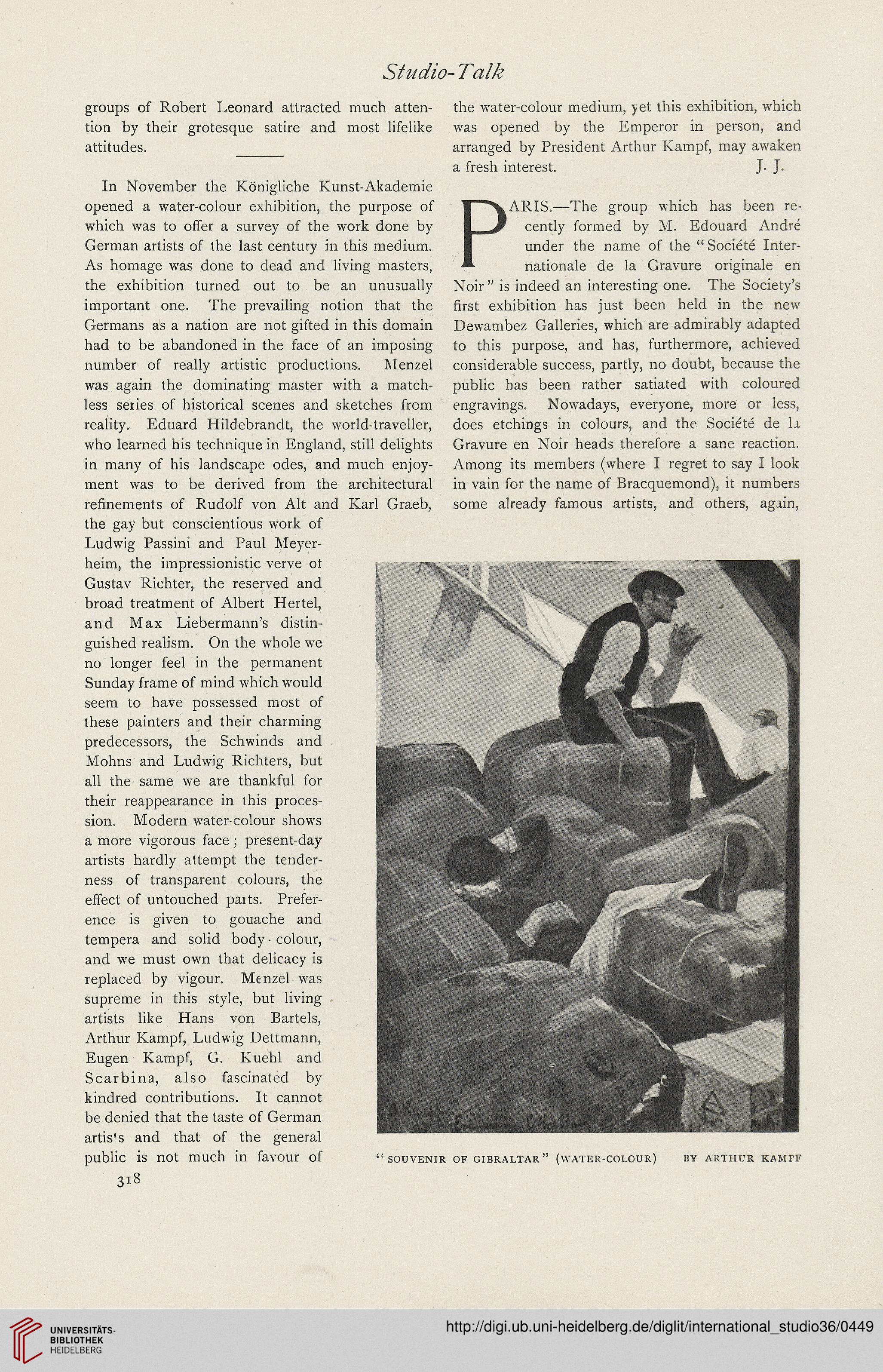?!?//&
groups of Robert Leonard attracted much atten-
tion by their grotesque satire and most lifeiike
attitudes.
In November the Konighche Kunst-Akademie
opened a water-colour exhibition, the purpose of
which was to offer a survey of the work done by
German artists of the tast century in this medium.
As homage was done to dead and living masters,
the exhibition turned out to be an unusuahy
important one. The prevaiiing notion that the
Germans as a nation are not gifted in this domain
had to be abandoned in the face of an imposing
number of realiy artistic productions. Menzei
was again the dominating master with a match-
less series of historical scenes and sketches from
reaiity. Eduard Hildebrandt, the world-travelier,
who learned his technique in England, still delights
in many of his landscape odes, and much enjoy-
ment was to be derived from the architectural
rehnements of Rudolf von Alt and Karl Graeb,
the gay but conscientious work of
Ludwig Passini and Paul Meyer-
heim, the impressionistic verve ot
Gustav Richter, the reserved and
broad treatment of Albert Hertel,
and Max Liebermann's distin-
guished realism. On the whole we
no longer feel in the permanent
Sunday frame of mind which would
seem to have possessed most of
these painters and their charming
predecessors, the Schwinds and
Mohns and Ludwig Richters, but
all the same we are thankful for
their reappearance in this proces-
sion. Modern water colour shows
a more vigorous face ; present-day
artists hardly attempt the tender-
ness of transparent colours, the
etfect of untouched parts. Prefer-
ence is given to gouache and
tempera and solid body - colour,
and we must own that delicacy is
replaced by vigour. Mtnzel was
supreme in this style, but living
artists like Hans von Bartels,
Arthur Kampf, Ludwig Dettmann,
Eugen Kampf, G. Kuehl and
Scarbina, also fascinated by
kindred contributions. It cannot
be denied that the taste of German
artis's and that of the general
public is not much in favour of
318
the water-colour medium, yet this exhibition, which
was opened by the Emperor in person, and
arranged by President Arthur Kampf, may awaken
a fresh interest. J- J.
n "^ARIS.—The group which has been re-
H -# cently formed by M. Edouard Andre
] under the name of the " Societd Inter-
nationale de 1a Gravure originale en
Noir" is indeed an interesting one. The Society's
hrst exhibition has just been held in the new
Dewambez Galleries, which are admirably adapted
to this purpose, and has, furthermore, achieved
considerable success, partly, no doubt, because the
public has been rather satiated with coloured
engravings. Nowadays, everyone, more or less,
does etchings in colours, and the Socidte de H
Gravure en Noir heads therefore a sane reaction.
Among its members (where I regret to say I look
in vain for the name of Bracquemond), it numbers
some already famous artists, and others, again,
"SOCVENtR OF GIBRALTAR" (WATER-COLOUR)
BY ARTHL'R KAMTF
groups of Robert Leonard attracted much atten-
tion by their grotesque satire and most lifeiike
attitudes.
In November the Konighche Kunst-Akademie
opened a water-colour exhibition, the purpose of
which was to offer a survey of the work done by
German artists of the tast century in this medium.
As homage was done to dead and living masters,
the exhibition turned out to be an unusuahy
important one. The prevaiiing notion that the
Germans as a nation are not gifted in this domain
had to be abandoned in the face of an imposing
number of realiy artistic productions. Menzei
was again the dominating master with a match-
less series of historical scenes and sketches from
reaiity. Eduard Hildebrandt, the world-travelier,
who learned his technique in England, still delights
in many of his landscape odes, and much enjoy-
ment was to be derived from the architectural
rehnements of Rudolf von Alt and Karl Graeb,
the gay but conscientious work of
Ludwig Passini and Paul Meyer-
heim, the impressionistic verve ot
Gustav Richter, the reserved and
broad treatment of Albert Hertel,
and Max Liebermann's distin-
guished realism. On the whole we
no longer feel in the permanent
Sunday frame of mind which would
seem to have possessed most of
these painters and their charming
predecessors, the Schwinds and
Mohns and Ludwig Richters, but
all the same we are thankful for
their reappearance in this proces-
sion. Modern water colour shows
a more vigorous face ; present-day
artists hardly attempt the tender-
ness of transparent colours, the
etfect of untouched parts. Prefer-
ence is given to gouache and
tempera and solid body - colour,
and we must own that delicacy is
replaced by vigour. Mtnzel was
supreme in this style, but living
artists like Hans von Bartels,
Arthur Kampf, Ludwig Dettmann,
Eugen Kampf, G. Kuehl and
Scarbina, also fascinated by
kindred contributions. It cannot
be denied that the taste of German
artis's and that of the general
public is not much in favour of
318
the water-colour medium, yet this exhibition, which
was opened by the Emperor in person, and
arranged by President Arthur Kampf, may awaken
a fresh interest. J- J.
n "^ARIS.—The group which has been re-
H -# cently formed by M. Edouard Andre
] under the name of the " Societd Inter-
nationale de 1a Gravure originale en
Noir" is indeed an interesting one. The Society's
hrst exhibition has just been held in the new
Dewambez Galleries, which are admirably adapted
to this purpose, and has, furthermore, achieved
considerable success, partly, no doubt, because the
public has been rather satiated with coloured
engravings. Nowadays, everyone, more or less,
does etchings in colours, and the Socidte de H
Gravure en Noir heads therefore a sane reaction.
Among its members (where I regret to say I look
in vain for the name of Bracquemond), it numbers
some already famous artists, and others, again,
"SOCVENtR OF GIBRALTAR" (WATER-COLOUR)
BY ARTHL'R KAMTF




